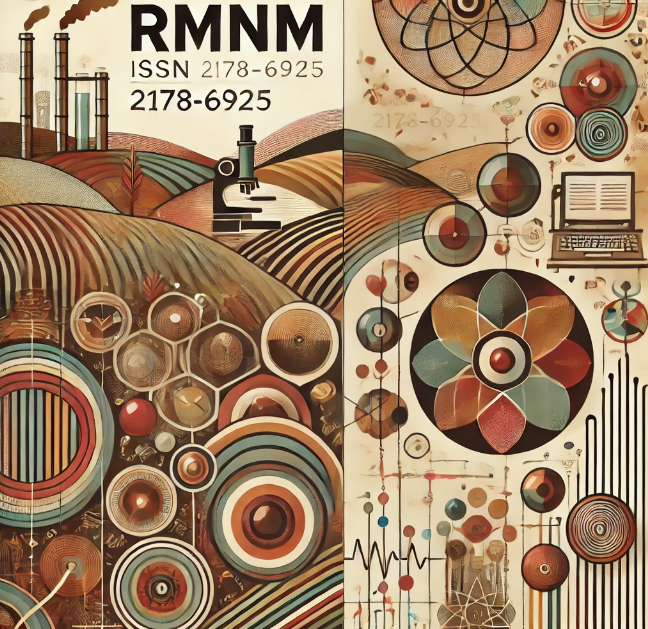COMPARATIVE ANALYSIS OF FLUORIDE RELEASE BY CONVENTIONAL AND RESIN-MODIFIED GLASS IONOMER CEMENTS: AN IN VITRO STUDY
DOI:
https://doi.org/10.61164/rmnm.v4i1.2295Keywords:
Forramento da cavidade dentária, Cimentos de Ionômeros de Vidro, Flúor, Materiais DentáriosAbstract
The objective of this study was to compare the fluoride release rate from Conventional Glass Ionomer Cement (GIC) and Photoactivated Glass Ionomer Cement, as well as infer the influence of the surface protection of the material with cavity varnish on this release. Using an in vitro methodology, a total of 84 specimens were divided into two groups: Group 1 (GICC) and Group 2 (GICP). Three subgroups (n=14) were created for each group: for conventional cements - Sample A (Vidrion R), Sample B (Vitro Fil), Sample C (Maxxion R), and for light-activated cements - Sample D (FIL FIL LC ), Sample E (Riva LC) and Sample F (Ionoseal). After complete polymerization of the specimens, half of the samples from each subgroup (7 samples) received surface protection with cavity varnish (Cavitine -SSWHITE). To compare the release of fluoride between materials, the Student's t-test was applied for independent groups. To determine whether there were significant differences in fluoride release over time, the repeated measures ANOVA test with multiple comparisons using Bonferroni adjustment was used. The greatest release of fluoride for varnish-coated materials occurred after 28 days (GICC = 27.97 ± 28.12; GICP = 15.73 ± 11.25). For GICs without varnish application, the greatest release of fluoride occurred after 21 days (GICC = 21.33 ± 19.65; GICP = 15.37 ± 16.68). No statistically significant differences were observed between the groups evaluated (p > 0.05). It was possible to conclude that GICs release fluoride at different time intervals and the surface protection of the cements did not negatively impact the release of fluoride from the analyzed materials.
References
BASSO, GR et al. Fluoride release from restorative materials. Brazilian Dental Journal, v. 22, p. 355-358, 2011. DOI: https://doi.org/10.1590/S0103-64402011000500001
BERG, JH, CROLL, TP. Glass ionomers restorative cement systems: an update. Pediatric Dentistry Journal, v. 37, p.116-124, 2015.
BHATIA, HP et al. A Comparative Evaluation of Sorption, Solubility, and Compressive Strength of Three Different Glass Ionomer Cements in Artificial Saliva: An in vitro Study. International Journal of Clinical Pediatric Dentistry, v. 10, p.49-54, 2017. DOI: https://doi.org/10.5005/jp-journals-10005-1407
CHAU NP et al. Relationship between fluoride release rate and anti-cariogenic biofilm activity of glass ionomers cements. Dental Materials, v. 31, p. 100-108, 2015. DOI: https://doi.org/10.1016/j.dental.2014.12.016
DE CALUWÉ, T et al. Addition of bioactive glass to glass ionomer cements: Effect on the physico-chemical properties and biocompatibility. Dental Materials. v. 33, n. 4, p. e186-e203, 2017. DOI: https://doi.org/10.1016/j.dental.2017.01.007
DOUGHTY, J et al. The dental public health implications of cosmetic dentistry: a scoping review of the literature. Community Dent Health, v. 33, p.218-224, 2016.
DUQUE, C et al. In vitro and in vivo evaluations of glass-ionomer cement containing chlorhexidine for Atraumatic Restorative Treatment. Journal of Applied Oral Science, v. 25, p.541-550, 2017. DOI: https://doi.org/10.1590/1678-7757-2016-0195
FRENCKEN, JE. The ART approach usingglass-ionomers in relation to global oral healthcare. Dental Materials, v. 26, p. 1-6, 2010. DOI: https://doi.org/10.1016/j.dental.2009.08.013
HAHNEL, S et al. Biofilm formation and release of fluoride from dental restorative materials in relation to their surface properties. Journal of Dentistry, v, 60, p.14-24, 2017. DOI: https://doi.org/10.1016/j.jdent.2017.02.005
HOSHIKA, S et al. Effect of Conditioning and Aging on the Bond Strength and Interfacial Morphology of Glass-ionomer Cement Bonded to Dentin. The Journal of Adhesive Dentistry,v. 17, p. 141-146, 2015.
KAMATHAM R, REDDY SJ. Surface coatings on glass ionomers restorations in Pediatric dentistry- Worthy or not? Journal of Indian Society of Pedodontics and Preventive Dentistry, v. 31, p.229-233, 2013. DOI: https://doi.org/10.4103/0970-4388.121818
KUCUKYILMAZ, E et al. Fluoride release/recharging ability and bond strength of glass ionomers cements to sound and caries-affected dentin. Nigerian Journal of Clinical Practice, v. 20, p. 226-234, 2017. DOI: https://doi.org/10.4103/1119-3077.178917
KUMAR, RS et al. Nanochitosan modificado vidro ionómero cimento com propriedades mecânicas melhoradas e fluoreto de libertação. International Journal of Biological Macromolecules, S0141-8130(16) 32665-4, 2017.
RANADHEER, E et al. Comparative Analysis of Microleakage of Zirconia-infused Glass Ionomer Cement with Miracle Mix and Amalgam: An In Vitro Study. Cureus, v. 10, p. e3672, 2018. DOI: https://doi.org/10.7759/cureus.3672
SHIOZAWA, M et al. Fluoride release and mechanical properties after 1-year water storage of recent restorative glass ionomer cements. Clinical Oral Investigations, v.18, p.1053–1060, 2014. DOI: https://doi.org/10.1007/s00784-013-1074-4
WIEGAND, A et al. Review on fluoride-releasing restorative materials, fluoride release and uptake characteristics, antibacterial activity and influence on caries formation. Dental Materials, v. 23, p. 343-362, 2007. DOI: https://doi.org/10.1016/j.dental.2006.01.022
ZHITKOV, MY et al. Comparative in vitro evaluation of modern glass ionomers cements for adhesion strength and fluoride release. Stomatologiia (Mosk), v. 95, p.58-62, 2016. DOI: https://doi.org/10.17116/stomat201695258-62
Downloads
Published
How to Cite
Issue
Section
License
Copyright (c) 2024 Revista Multidisciplinar do Nordeste Mineiro

This work is licensed under a Creative Commons Attribution-NonCommercial-ShareAlike 4.0 International License.




